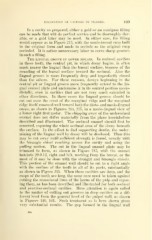Page 383 - My FlipBook
P. 383
EXCAVATION OF CAVITI KS LJV CLASSES. 169
In a cavity so prepared, either a gold or an amalgam filling
can be made that will do perfect service and be thoroughly dur-
able, or a gold inlay may be used. In either case, the filling
would appear as in Figure 213, with the mesio-buccal cus]) l)uilt
to the original form and made to occlude as the original cusp
occluded. It is rather unnecessary labor to carve sharp grooves
in such a filling.
The LINGUAL GROOVE IN LOWER MOLARS. lu occlusal cavitics
in these teeth, the central pit, in which decay begins, is often
much nearer the lingual than the buccal surface, because of the
rounding of the buccal surface toward the occlusal. Also the
lingual groove is more frequently deep and imperfectly closed
than the others. For these reasons, decays beginning in the
central pit or lingual groove moi-e frequently extend to the lin-
gual enamel plate and undermine it in its central portion mesio-
distally, even in cavities that are not very much extended in
other directions. In these cases the lingual groove should be
cut out over the crest of the marginal ridge and the marginal
ridge itself removed well toward both the disto- and mesio-lingual
cusps, as shown in Figiires 214, 215, in a mesio-lingual view of
a lower right first molar. The chipping away of the undermined
enamel does not differ materially from the plans hereinbefore
described and illustrated. The occlusal enamel should first be
removed, exposing the whole occlusal area of the decay beneath
the surface. In the effort to find supporting dentin, the imder-
mining of the lingual wall by decay will be disclosed. Then this
may be cut away until sufficient strength is found, iisually with
the binangle chisel reaching across the cavity and using the
pulling motion. The cut in the lingual enamel plate may be
trimmed to form, as shown in Figure 215, with the enamel
hatchets 20-9-12, right and left, working from the buccal, or the
most of it may be done with the straight and binangle chisels.
This portion of the enamel wall should be cut to a right angle
with the surface of the tooth in all of its parts, sulistantially
as shown in Figure 215. When these cavities are deep, and the
cusps of the teeth are long, the same care must be taken against
cutting the recessional lines of the horns of the pulp and expos-
ing them, as has been described and illustrated for both occlusal
and proximo-occlusal cavities. Here attention is again called
to the matter of cutting out grooves in deep cavities on a dif-
ferent level from the general level of the pulpal wall, as shown
in Figures 140, 141. Such treatment as is here shown gives
very substantial results. The gap foi-med in the lingual wall
24a


